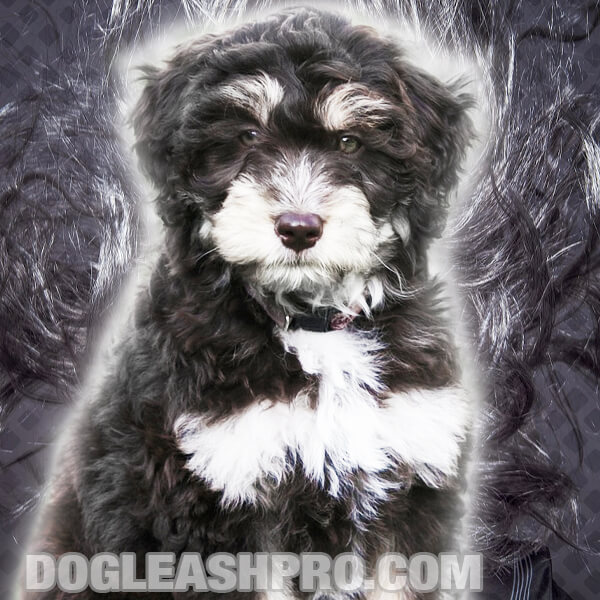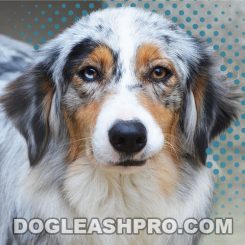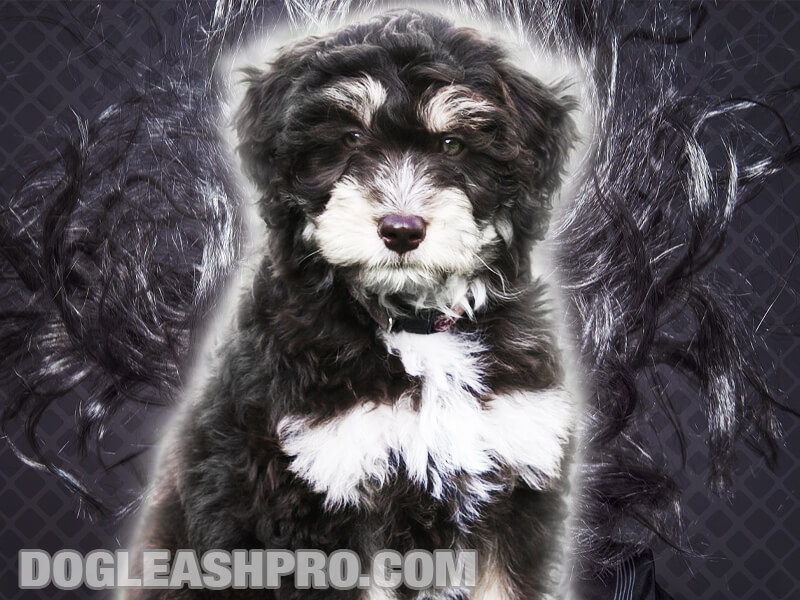
If you’re interested in having an Australian Shepherd, but have canine allergies, you may want to consider the Aussiedoodles. Aussiedoodles are loyal companions that enjoy being with their owners. But you may be wondering how much does Aussiedoodles shed and if they shed at all. Here’s the short answer first.
Do Aussiedoodles shed? Yes, all canines shed. However, Aussiedoodles are among the lowest shedding pooches. They have curly hair, which doesn’t allow loose fur to fall off. This gives the impression that the pup is non-shedding. Aussiedoodles also tend to have single coats that shed less than double coats.
Table of Contents
Do Aussiedoodles Shed?
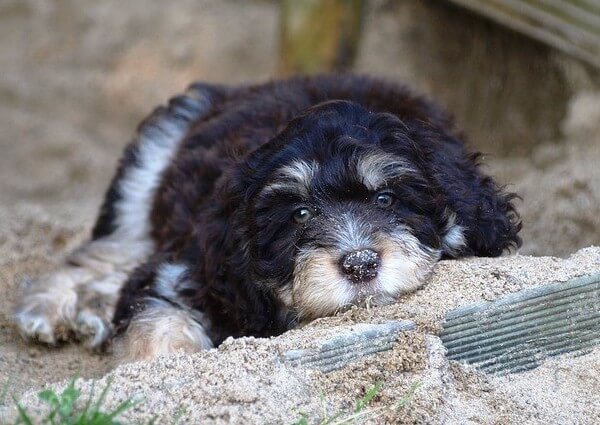
Yes, Aussiedoodles do shed, but they are low shedding dogs. So how much do they shed?
While we know that all canines drop their dead hair as we do, Aussiedoodles do so minimally. They shed so infrequently that many people consider them non-shedding pups.
But what’s the reason behind their minimal shedding? For that, we’ll have to describe what an Aussiedoodle is.
What are Aussiedoodles?
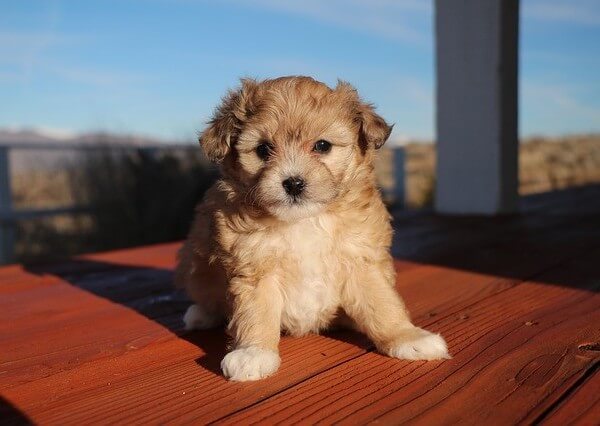
Doodles are pups created by mixing Poodles with another breed. They are popular among pet enthusiasts due to their superior health and low-shedding coats. The Aussiedoodle is one such Poodle mix.
Made by crossing an Australian Shepherd with a Poodle, the Aussiedoodle is a “designer mix.” A designer mix is a carefully curated cross of two dog breeds and has the most desired characteristics of both breeds.
In Aussiedoodle’s case, a low shedding coat is the most in-demand characteristic. However, breeders may tinker with other tendencies to make them appeal to pet lovers with specific requirements, including aiming for a certain size, temperamental qualities, color, and energy level.
You might also like: Australian Goldendoodle – Complete Guide
Aussiedoodle coat types
The Australian Shepherd has a straight double coat, whereas the Poodle has a single curly coat. If you mix these two, you get an Aussiedoodle pup that’s 50% Australian Shepherd and 50% Poodle. It also means that you can get a straight coat, a curly coat, or something in-between.
Crossbreeding is not an exact science, and you don’t always get your desired outcome. Even Aussiedoodles in the same litter can have different hair.
So, when it comes to Aussiedoodle coats, they can have one of three textures.
1. Curly coat
A curly coat is what breeders aim for when producing the Aussiedoodle. These coats have tight curls, and it’s those curls that make Aussiedoodles a hypoallergenic breed.
Curly hair Aussiedoodles shed too, but their shedding isn’t easily noticeable as they don’t leave their hair everywhere. The long curly fur hooks into each other, keeping loose hair strands from falling off.
This curly coat is also single, meaning there is no undercoat that sheds or blows out when the season changes.
The downside of the curly coat is that it requires more grooming than the other types. Curly hair Aussiedoodles need daily brushing to keep their fur from tangling and forming mats. Their bathing frequency is also higher, and they also need regular haircuts to keep their hair from getting messy.
2. Wavy coat
Sometimes, an Aussiedoodle inherits coat features from both his parents. In this case, the fur won’t be as curly as a Poodle, nor would it be as straight as an Australian Shepherd. Instead, these Aussiedoodles have a long or medium-length wavy coat.
This wavy coat isn’t as good at holding on to loose fur as the curly coat. Unfortunately, this means your Aussiedoodle will shed a bit more, and he won’t be completely hypoallergenic.
On the plus side, these coats are relatively easier to groom. Wavy hair Aussiedoodles also lack an undercoat, which means they don’t shed as heavily as the straight hair Aussiedoodle. You’d still need to brush them twice a week and take them for a haircut every few months.
3. Straight coat
When an Aussiedoodle takes after his Australian Shepherd parent, the result is a straight coat. This straight coat is medium-length and has an undercoat that “blows out” twice a year.
Blowing out is how the pup gets rid of its fur and grows new hair that suits the coming season.
The Aussiedoodle straight hair strands are incapable of hooking onto each other and fall right off the pup when they shed. This means your Aussiedoodle won’t be hypoallergenic, and their shedding will be more noticeable.
As you can guess, these pups are easier to maintain. Their coat doesn’t tangle frequently, and brushing their fur once a week is enough. Since these Aussiedoodles shed more often, they don’t need haircuts either.
Aussiedoodle coat colors
Aussiedoodles can inherit the coat color of one of their parents, or they can have a combination of both parent breeds.
Poodles come in numerous coat colors, but the AKC only recognizes them in solid coats. Australian Shepherds come in just four colors.
So, the Aussiedoodle can have the following coat colors:
- Black.
- Red.
- Apricot.
- Café Au Lait.
- Blue.
- Blue merle.
- Red merle.
- White.
- Silver.
- Beige.
- Cream.
- Grey.
- Any combination of the above colors.
Aussiedoodle coat changes
Some Poodles don’t stay in one coat color for their whole lives. They change colors as they transition into adulthood. This color change is more noticeable in dark-haired Aussiedoodles.
The color transformation is due to a greying gene, which Aussiedoodles may inherit from their Poodle parent. This gene causes the coat color to fade, and it happens when your doodle is around 6 to 10 months old.
If the color change happens, black doodles turn blue, grey doodles turn silver, brown doodles turn silver beige or Café Au Lait, and Sable doodles turn cream or off-white. The change isn’t as noticeable in other coat colors.
Are Aussiedoodles hypoallergenic?
We know that Aussiedoodles shed minimally and don’t drop loose fur everywhere, but does that make your Aussie Poo hypoallergenic? The answer is yes—for most people.
While almost everyone is ok with an Aussiedoodle, some people with extreme sensitivities may even have Aussiedoodle allergies.
While it’s true that some canines don’t trigger allergies, no breed is 100% hypoallergenic. That’s because all dogs shed to some extent. But shedding fur isn’t the only issue. Even dogs with no hair can trigger a reaction. That’s because fur is only one component that troubles people with canine allergies.
Other factors like dander, urine, and saliva are all allergy triggers. However, Aussiedoodles are pretty clean in that regard as well. They don’t spread dander, drool minimally, and you can potty-train them so they don’t urinate in your house.
Check out: Find out if F2B Goldendoodles are hypoallergic in our article, F2B Goldendoodle: Complete Guide!
Do mini Aussiedoodles shed?
Partnering Australian Shepherds with mini Poodles produces mini Aussiedoodles. Since they are smaller than regular Aussiedoodles, people often ask, “do mini Aussiedoodle shed?”
The only thing that’s different about the mini Aussiedoodles is their Poodle parent’s size. If they inherit the same curly coat, you can expect them to shed minimally. This low shedding also gives them similar hypoallergenic properties as Poodles.
Are mini Aussiedoodles hypoallergenic?
You can consider your mini Aussiedoodle hypoallergenic if he has a curly Poodle coat. Aside from shedding less than other canines, mini Aussiedoodles also produces less dander, and they don’t drool a lot either. All these factors make them perfectly suited for people with canine allergies.
Do toy Aussiedoodles shed?
Toy Aussiedoodles are bred by partnering an Australian Shepherd with a toy Poodle. These pups are also low-shedding—provided they inherit the curly coat of their Poodle parent. This low shedding, combined with their minimal drooling tendency and low dander production, makes them hypoallergenic.
Do F1b Aussiedoodles shed?
You’ll often come across Aussiedoodles with alphabets and numbers before their names. These prefixes represent the generation and parentage of a doodle.
F1b Aussiedoodles are made by breeding an Aussiedoodle with a purebred Poodle. This makes them 75% Poodle and more likely to be non-shedding and hypoallergenic. In other words, most F1b Aussiedoodles you’ll come across will have low-shedding coats.
Do F1 Aussiedoodles shed?
F1 Aussiedoodles are first-generation Aussiedoodles. In other words, they are the offsprings of partnering a purebred Australian Shepherd with a purebred Poodle. These pups are a 50-50 mix of Australian Shepherds and Poodles, meaning there’s a high chance of getting an Aussiedoodles that sheds more. Regardless, F1 Aussiedoodles do shed.
You may be interested in: F1B Cavapoo – Complete Guide
Do Aussiedoodle puppies shed?
Yes, Aussiedoodle puppies do shed. Aussiedoodle puppies have the same low-shedding coats as adult Aussiedoodle. After the six-month mark, puppies shed excessively for a while. This high-shedding phase continues while the pup transitions from puppy coat to adult coat.
All the puppy fur falls off on its own by the time your Aussiedoodle puppy is an adult.
Do Aussiedoodles shed their puppy coat?
Yes, Aussiedoodles shed their puppy coat when they’re old enough. A puppy coat is what puppies wear from birth to about 4 to 6 months. After that, the puppy coat sheds, and the doodle grows the coat he will have for the rest of his life.
While the puppy coat shedding is noticeable in other breeds, Aussiedoodles do so subtly. This means they don’t leave hairballs all over your house when transitioning into their adult coat. The only prominent indication of them shedding their puppy coat will be the extra fur when you brush them.
Do Aussiedoodles shed a lot?
Aussiedoodles can inherit their coat from either parent. This means those Aussiedoodles who inherit the Australian Shepherd coats will shed more noticeably than an Aussiedoodle that has a curly Poodle coat.
Curly-haired Aussie Poos shed too, but their shedding isn’t that evident. On the other hand, straight-haired Aussiedoodles shed more prominently. In either case, the shedding isn’t too excessive, and you can manage it by regular brushing.
How much do Aussiedoodles shed?
Aussiedoodles shed as much as some other single-coat canines. However, their shedding is less noticeable as their curly hair latch onto their coat instead of falling off. Since they don’t leave their fur everywhere, they are often called “non-shedding.”
If your Aussiedoodle inherits the Australian Shepherd double coat, he will shed moderately all year round and excessively during the spring and fall seasons. This period is when these doodles blow off their coats to grow one that suits the oncoming season. That won’t be a problem if your Aussie Poo has a single Poodle coat.
How healthy are Aussiedoodles?
Aussiedoodles aren’t just low-shedding hypoallergenic canines; they’re also very healthy. This is due to them having hybrid vigor. In other words, Aussiedoodles inherit the best qualities from both parents and are sturdier and healthier than them.
However, owners should still be wary of the following common health issues.
1. Progressive Retinal Atrophy (PRA)
Progressive Retinal Atrophy or PRA is a group of congenital eye diseases. The disease starts with night blindness and slowly progresses to total blindness, which is unfortunately irreversible.
2. Cushing’s disease
Cushing’s disease is a known disorder in Poodles. Its symptoms include a protruding belly, excessive thirst, and frequent urination. It happens when too much of the cortisol hormone is in your doodle’s bloodstream.
3. MDR1 mutation
MDR1 mutation exists among merle pups and can cause them to have adverse drug reactions. Merle Doodles with this gene are highly sensitive to Ivermectin: a common ingredient found in deworming medicines.
RELATED: Merle Poodle – Complete Guide
4. Legg-Calve Perthes disease
When this disease sets in, it causes severe pain and lameness in one or both of your doodle’s rear legs. You’d generally find it in young, growing doodles.
5. Hip and elbow dysplasia
Elbow and hip dysplasia is a crippling disease that causes your dog’s front and back legs to become weak, crooked, sore, and painful. The symptoms include difficulty walking and running.
6. Sebaceous adenitis
This disease causes your doodle to lose his fur. It starts with hair loss on the lower back and moves downward. The condition gradually progresses toward the upper back, neck, face, legs, tail, and rear area. However, this disease isn’t fatal.
7. Cataracts
Cataracts are when the lenses in your pup’s eyes become cloudy, causing blindness. Cataracts usually affect senior canines and require surgical treatment.
8. Pancreatitis
Pancreatitis is a severe ailment in canines that causes them to have stomach aches and diarrhea. It occurs when the pancreas becomes inflamed. In severe pancreatitis, digestive enzymes flow directly into the digestive tract from the pancreas, causing damage to vital organs.
You might also like: My Dog Has Diarrhea But Is Acting Fine
Can shedding be connected with different health issues?
Yes, shedding can be connected with different health issues in Aussiedoodles. Several health issues can lead to your pup shedding more than usual. These include:
- Stress and anxiety.
- Demodex mange.
- Fleas, ticks, and parasites.
- Skin allergies.
- Thyroid imbalance.
- Bacterial or fungal infection.
- Immune disease.
- Sebaceous adenitis.
Can Aussiedoodles’ poor diet affect the amount they shed?
Several diet-related issues can lead to health problems such as excessive shedding:
Low-quality food
Cheap, low-quality dog food can have adverse effects on your Aussiedoodle’s health. These foods lack the essential nutrients and mostly contain filler ingredients that provide them with no nutritional benefits.
Food allergies
Patchy hair loss is one of the symptoms of food allergies. Food allergies could include grain, wheat, or soy allergies. When you feed your pooch something new, always start with a tiny amount and watch for any adverse effects.
Dietary deficiencies
Sometimes, it’s not possible to get all the necessary nutrients from food alone. Plus, your canine might have pre-existing deficiencies. These deficiencies also affect your Aussiedoodle’s coat.
In these cases, consult with your dog’s vet and they may prescribe appropriate and necessary dietary supplements.
Sudden change in diet
A sudden change in routine and eating habits can result in stressing your pup’s digestive system. This stress can also lead to excessive shedding.
How to face Aussiedoodle shedding
Grooming an Aussiedoodle is not like grooming any other pooch. These canines have higher grooming needs due to their long curly fur. Aussiedoodle owners will need to groom their dogs in between grooming appointments and they needs to have certain tools at their disposal to keep their pup’s coat looking in top form.
Slicker brush
Slicker brushes are designed for canines with long, curly hair that tangles easily. You’d need to brush your Aussiedoodle daily with a sturdy slicker brush.
Detangling comb
Using a slicker brush works most of the time, but it won’t be as effective if your Aussiedoodle has tangles or mats in his fur. Use a special detangling comb or de-matting brush to get rid of knots quickly and easily.
Detangling spray
Pulling on mats can be painful for your Aussiedoodle, and a detangling spray can make the process easier. Detangling sprays make your Aussiedoodle’s fur slippery, allowing a detangling comb to remove the mats without pain.
Scissors
Some mats are just too big and stubborn. Instead of trying to force those out, it’s less hurtful to snip them off instead. A sharp pair of scissors will get rid of the mat quickly and painlessly.
Shampoo
A dog-friendly mild shampoo especially catered for Aussiedoodles will keep your Aussiedoodle’s coat clean, shiny, and soft.
Microfiber towel
After each bath, dry your Aussiedoodle with a microfiber towel. Using a regular towel causes friction and makes their hair frizzy, which may lead to tangles.
Blow-dryer
Leaving your Aussie Poo with damp fur after a bath can lead to skin irritation. A quick blow-dry after will dry your pup’s hair quickly and effortlessly.
Can dog owners control or limit Aussiedoodles shedding?
The way you maintain your Aussiedoodle also affects how much they shed. Whether you have a straight, wavy, or curly hair Aussiedoodle, there are always things you can do to keep his shedding to a minimum.
- Bathing your Aussiedoodle regularly will keep his skin and fur clean and healthy. Curly Aussiedoodles need a wash every two weeks, whereas wavy or straight hair Aussiedoodles only need a bath after a month or two.
- Using soaps, detergents, or shampoos with harsh chemicals can damage and weaken your Aussiedoodle’s fur, leading to hair loss. Always use dog-friendly hair care products.
- Visiting a professional canine groomer every 3 to 4 months can keep your Aussiedoodle’s hair from getting too messy.
- Daily brushing will keep your Aussiedoodle’s coat free from mats, dirt, debris, and dead fur.
- A healthy, balanced diet catered to Aussiedoodles will ensure your pup doesn’t suffer from any diet-related hair loss. You should also ensure your pooch isn’t allergic to anything you’re feeding him.
- Timely vaccinations, visiting the vet regularly, and monitoring your Aussiedoodle for any abnormalities will prevent health-related fur loss.
Related Questions
Yes, all Aussiedoodles shed. However, they don’t shed as frequently or noticeably as other canines.
Australian Shepherds are medium-shedding canines, whereas Labradors are a high-shedding breed. So, we can say that Labradoodles shed more than Aussiedoodles.
DISCLAIMER: THIS WEBSITE DOES NOT PROVIDE MEDICAL ADVICE
The information, including but not limited to, text, graphics, images and other material contained on this website are for informational purposes only. No material on this site is intended to be a substitute for professional veterinary advice, diagnosis, or treatment. Always seek the advice of your veterinarian or other qualified health care provider with any questions you may have regarding a medical condition.
Resources:
https://www.wikihow.life/Identify-an-Aussiedoodle
https://www.ncbi.nlm.nih.gov/pmc/articles/PMC5809771/

With over five years of specialized experience as an animal writer, my expertise lies in dog nutrition, health, behavior, grooming, and training. I am dedicated to delivering helpful and informative content that caters to the well-being of our furry friends. My primary goal is to empower pet owners with knowledge and ensure our canine companions thrive in health and happiness. In my free time, I love volunteering at local dog rescue centers.
